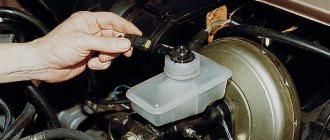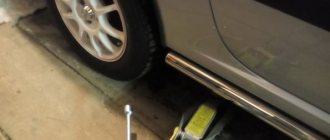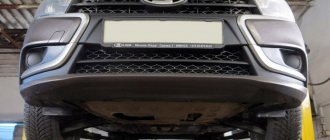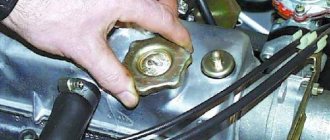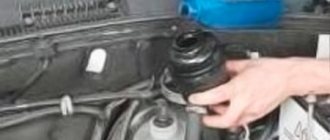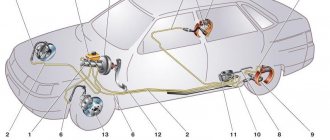Every motorist has encountered a situation where it is necessary to change or add brake fluid to the system. If you regularly carry out technical inspection and maintenance, then no problems will arise in the future. It will be enough to simply change the specialized fluid, following the manufacturer’s recommendations. It is worth noting that brake fluid comes in different types; this should not be forgotten. If you upload the wrong version, troubles will arise over time.
But there are times when damage to the brake system occurs on the road, far from your garage or service center. In this situation, many drivers simply add fluid to get the required level. Due to this, you can get to the place and completely replace the system. It will be good if the driver is prudent and carries with him a sufficient amount of special fluids and the like. Otherwise, you will have to fill in the first one you come across, which is sold in the nearest store. And this is quite bad, since you do not know the quality of the product and its features. Before filling, you should consider whether the purchased product can be mixed with the one in the brake system. We will try to answer a similar question in this article.
Types of brake fluid
Currently, you can find several types of brake fluids:
1) DOT – 3. This type of liquid has an oily base and a light brown tint. The boiling point is within 200 degrees Celsius. Recommended for vehicles equipped with a drum brake system, such as trucks and similar vehicles. Everyone knows that during braking, the drum system heats up much less than the disc system;
2) DOT-4. This variety has a transparent color, in some cases a light brown tint. As for the boiling point, it varies within 230 degrees Celsius. Suitable for all motorcycles and some passenger cars;
3) DOT-5. Brake fluid has a reddish tint and a boiling point of around 180 degrees Celsius. Recommended for use in sports vehicles and high-performance motorcycles. After all, this requires not only good dynamic properties, but also an excellent braking system;
4) DOT-5, 1. Has an oily base, like all other brake fluids. A small feature is the boiling point; it varies within 260 degrees Celsius. As for the color itself, the brake fluid has a yellowish tint. Essentially, this is a slightly improved version when compared to the previous generation.
How often do you change the fluid?
It is recommended to change the brake fluid at least once every two years, regardless of the car model, since it works under difficult operating conditions - it heats up to a high temperature during frequent braking. The “brake fluid” is also hygroscopic, and over time moisture accumulates in its composition, which reduces the boiling point of the fluid. If too much moisture accumulates, the fluid will boil when braking, and the car’s brakes will fail.
You should also change the brake fluid:
1) when buying a used car - it is unknown when the previous owner last serviced the vehicle;
2) when the liquid becomes cloudy or sediment appears in it.
The industry has developed special testers that check the hygroscopicity of fuel fluid; an example is the Novitec device. There are four indicators on its front panel:
When the green Gut indicator lights up on the tester when checking the brake fluid, this means that the brake fluid meets the requirement of hygroscopicity and does not contain water in its composition. 1% - the condition of the brake fluid is satisfactory, 2 and 3% - the fluid needs to be changed, it is not suitable for further use.
Our brand
General recommendations in all cases of work when changing the fluid on a car with your own hands:
- Do not allow the chemical to come into contact with your hands, inside the body, or on wires or paintwork;
- it is necessary to use exactly the chemical specified by the manufacturer of the car brand;
- Store leftovers in containers tightly closed.
So, as an example, let’s look at the operation of replacing the brake fluid on a VAZ 2110 car. We’ll describe what you need to have on hand below:
How much liquid we need is indicated by the car's passport. For VAZ 2110 this is 0.55 liters. Let's get started.
- Open the system reservoir.
- We lift the rear of the car, unlock the rear brake pressure regulator - insert a screwdriver between the piston and the plate.
- We release the air release valve of the right rear brake from the rubber cap, insert a hose, the end of which is connected to a container.
- The partner must sharply press the pedal 5 times, and leave it pressed the last time.
- At the same time, we unscrew the valve with a wrench - just make three quarters of a turn, the spent medium should begin to flow out. After the leak stops, tighten the valve, and your partner should not release the pedal until the fitting is tightened.
- It is necessary to add new medium as soon as the tank is empty to the bottom mark. When clear liquid flows out, the operation stops.
- We repeat everything completely on the left front brake mechanism.
- Then we repeat the manipulations again for the second circuit - first we move to the left rear mechanism, and at the end - to the right front.
- We install the caps back, remove the screwdriver from the pressure regulator, and check the efficiency of the system.
This is how the brake fluid is replaced on a VAZ 2110. Dividing the system into two independent circuits for greater safety should not be a surprise - just remember the driving school lessons.
Replacement for the VAZ 2114 is carried out in exactly the same way. If we talk about the Lada Kalina, then there are no differences either. Changing Kalina's fluid is done according to the same instructions. The only thing worth paying attention to is how much brake fluid Kalina needs for a complete replacement. The volume here is 0.45 liters.
On the Lada Priora we act identically. Replacing Priora also does not cause any particular difficulties. The volume of the new medium is also 0.45 liters. For all these cars, it is recommended to use DOT 3. The replacement frequency for front-wheel drive VAZs is from 2 to 3 years or from 50 to 60 thousand km. mileage
What does brake fluid consist of?
Combines all brake fluids, with the exception of DOT-5, their base component is polyethylene glycol. The base for creating DOT-5 is silicone. You should remember that the composition of DOT-5.1 is fundamentally different from its consonant DOT-5. If there is an emergency, a combination of DOT-3, DOT-4 and DOT-5.1 is permissible, since they have a common base. Even better if they were produced by the same manufacturer. At the same time, we must not forget that by adding another liquid, DOT-3, to the DOT-4 liquid, you thereby lower the boiling point of the first. If you mix fluids made from different components, that is, silicone and polyethylene glycol, the reaction between them results in the formation of a composition that simply is not brake fluid, which is extremely dangerous for further movement.
Which liquids should be mixed and which should not be mixed:
Based on the above, it is worth remembering that under no circumstances should you:
Delivery by transport company
Delivery by one of the transport companies with a representative office in your city. Delivery time: 2-10 days depending on the distance of your locality from Togliatti. The most convenient and fastest way to deliver orders of different sizes. Delivery cost from 250 rub. depending on weight and delivery distance.
Orders are sent by transport companies based on 100% payment for the order. Dispatch by transport companies PEK, KIT, Baikal-Service is carried out on Wednesday, Thursday and Friday.
Source
How often should you change brake fluid?
It is recommended to change the TZ at least once every two years, regardless of the car model, since it operates under difficult operating conditions - it heats up to high temperatures with frequent braking. “Brake fluid” is also hygroscopic, and over time moisture accumulates in its composition, which reduces the boiling point of the fluid. If too much moisture accumulates, the fluid will boil when braking, and the car’s brakes will fail.
You should also change the brake fluid:
- when buying a used car - it is not known when the previous owner last serviced the vehicle;
- when the liquid becomes cloudy or sediment appears in it.
The industry has developed special testers that check the hygroscopicity of fuel fluid; an example is the Novitec device. There are four indicators on its front panel:
When the green Gut indicator lights up on the tester when checking the brake fluid, this means that the brake fluid meets the requirement of hygroscopicity and does not contain water in its composition. 1% - the condition of the brake fluid is satisfactory, 2 and 3% - the fluid needs to be changed, it is not suitable for further use.
Is it possible to mix different types of brake fluid?
In old cars, BSK brake fluid was once used; it was red in color - the dye was added to it specifically so that fluid leakage could be determined by its color. Modern cars often use yellowish DOT-4 type fluid, and in this case it is impossible to mix liquids of different colors - when mixing BSK and DOT-4, the brake fluid may foam, and the brake cylinder cuffs will also swell.
The basis of modern brake fluids of the DOT-3/ 4/ 5.1 type is polyethylene ethylene glycol, therefore these types of brake fluids are similar in composition. It is permissible to mix them, but it is not advisable, since liquids of different brands differ in characteristics, for example, they have different boiling points.
The basis of DOT-5 brake fluid is silicone, and its composition is in no way compatible with DOT-4 type brake fluid. Mixing DOT-5 and DOT-4 is not allowed; when they are combined, a chemical reaction occurs, as a result of which all rubber seals in the vehicle are corroded.
How to Check Brake Fluid Condition Using a Handheld Tester
Using a tester, it’s very easy to check TF for hygroscopicity; to check, in addition to the device itself, you will also need a clean container (jar or glass) and a medical syringe:
- unscrew the cap of the brake system reservoir, take out a small amount of fuel fluid with a syringe;
- pour the liquid into a glass;
- lower the tester probe into the container with fuel fluid, press the device power button;
- We look at the indicators - in this case, all the LEDs lit up, including the 3% indicator. This indicates that the brake fluid contains at least 3% water, so the fluid must be changed.
How to replace this plug?
Replacement is very simple and quick, literally in 15 seconds:
- First, unscrew the old plug and remove it
- Then disconnect the wire plug
- Install the new one in reverse order
This cover has a slightly different float material, something like foam or polyurethane (I don’t know exactly), while the factory one would have been plastic. I hope that there will be no misunderstandings with this.
Source
Flushing the brake system
The vehicle must be washed in the following cases:
- if one type of brake fluid changes to another;
- in case of cloudiness of the fuel fluid or precipitation in it;
- if there is a large amount of moisture in the old fluid.
Often the fuel fluid is completely changed with the car owner flushing the system after purchasing a used car - the driver does not know what fluid was poured into the vehicle, so in this case it is easier to drain the old brake fluid, flush the system and fill in a new fuel fluid.
There are two options for flushing the system - with new brake fluid or industrial alcohol. To flush a new fuel tank, it must be purchased with a reserve of 50-70% more than what is needed to fill the brake system. The washing principle is as follows:
- using a syringe, the liquid is pumped out of the tank;
- the brakes are pumped until fresh fuel fluid flows from the fittings;
- the operation is repeated several times, then the system is filled with new “brake fluid”, and the brakes are finally pumped.
There is an option for flushing using compressed air or disassembling the brake cylinders, but the principle is the same - you need to completely remove the old brake fluid from the system.
Modern brake fluids are quite technologically advanced; they can withstand high temperatures, as well as high pressure in the brake system of a modern car. They are not compressible and therefore they are used in the braking system of a car, that is, compressing, like gas or air, cannot be done. That is why the car’s system is liquid; it has proven its reliability (in fairness, it is worth noting that there are also pneumatic options). BUT, the hydraulic option still has some minor drawbacks - it can leak, for example, if the brake hose breaks, but you still need to drive! But what to do if you don’t have exactly the same composition as you (the original was filled in from the dealer)? Then a fair question arises - is it possible to mix brake fluid from different manufacturers and different classes, say, pour DOT3 into DOT4 - what will happen? As usual, the article will be extensive + video version at the end, so read and watch...
It is worth noting that brake fluid has gone through a long period of evolution, as usual, everything originated with mineral compounds, then glycol ones appeared (now the most commonly used), then silicone ones (many people say the future belongs to them, but I don’t quite agree). So what caused this leap in development? YES, everything is simple, cars are becoming faster, the speeds are prohibitive, and therefore the mineral mixtures that were available before simply do not meet these requirements.
Drain
First of all, during replacement, the old fluid is drained. It is performed as follows:
- The lid of the tank needs to be unscrewed. It contains brake fluid. The lid can be put aside, but it is better to place a rag under it, since the composition is in excellent contact with surrounding surfaces, without affecting them very well.
- The next step is to unlock the pressure regulator on the rear wheels, if necessary. To unlock this design, you will need to install a screwdriver between the plate and the piston.
- After this, you should prepare a hose and a container to drain the old fluid. It is best to use an empty bottle if you don’t have a container at hand. Before draining, it is necessary to clean the fitting from dirt using a brush. Subsequently, a hose will be attached to the fitting.
- Once the fitting is cleaned, you will need to remove the cap from it and insert one end of the hose into the hole, and the other should go into a container or bottle. Then you will need the help of a second person. He will need to get into the car and press the brake pedal several times. This must be done sharply so that the liquid can be drained, but between each press it is necessary to maintain a short break.
- As soon as the liquid stops flowing, you need to pull the hose out of the hole, wipe the fitting with a rag and close it with a lid. In this case, it is important to tighten the cap correctly. So, for example, if during the process of unscrewing it was loosened by 3/4, then it should be tightened by the same amount.
- The final action will be to begin pouring the new compound while tightening the fitting. As soon as new liquid begins to flow out of the existing hole, you can screw the cap on completely.
This fluid drain diagram is for rear brakes. As for the front ones, the procedure is practically no different. The main difference is only in the location of the fittings, but this will not be a problem if you familiarize yourself with the structure of the car and the brake system in advance.
Thus, the brake fluid is drained from both the front and rear brakes, after which it will be possible to begin filling in new fluid.
Dry and wet mixture
At the very beginning, I would like to talk about the hygroscopicity of brake fluid (for those who don’t know, this is the ability to absorb moisture from the environment). That is why it must be changed after a certain period of time, on average every 2 - 4 years, it all depends on the class (more on this below).
So, when you have just opened a sealed jar (which has not had contact with the surrounding air), and want to pour it into the main tank, then this composition will be called DRY , because there is no moisture there at all! After all, it just opened.
But if your car or open can was in contact with air (the can may have been lying open on a shelf for a couple of years). The liquid has already absorbed a large percentage of moisture! Moreover, only 3.5% is enough so that it can no longer be used in the braking system! This mixture is called MOISTURIZED (it simply contains water)!
conclusions
It is simply necessary to periodically replace the brake fluid on Kalina. This is due to chemical and physical properties that may be lost during operation. Thus, the choice of fluid must be approached quite carefully, since traffic safety depends on it.
I think when buying brake fluid, you don’t need to overpay for liquid moth. DOT-4 does an excellent job, despite the price, I completely agree with the author.
To bleed the brakes, have anyone sit in the car. Let him press the brake pedal 3-5 times until it becomes elastic. Open the valve on the caliper and release the air. Repeat the operation until air comes out of the system completely.
I don’t remember, but it seems to me that I intuitively understood everything myself. When I changed the brake fluid for the first time, but I never bother with brands, I always take something of an average price.
We carry out the work on an inspection ditch or overpass.
DOT classification
To begin with, what is DOT anyway? If you decipher it, it turns out that the Department Of Transportation (Or Department of Transport) is located in the jurisdiction of the United States. So this department decided to distinguish between different compositions by class - as a result, DOT1 appeared, and then others.
DOT1 - DOT2 - these are the very first brake fluids, they were based on mineral substances, now they are practically not used, so we won’t bother with them, although I will note them for general development. They were used on low-speed vehicles, speeds up to approximately 40 - 60 km/h, and under heavy loads they could boil quite quickly. As a result, they very quickly lost their characteristics.
Now a small remark - ask, why could it boil? Yes, everything is simple: when the car slows down, and the slope is prolonged, the wheel rims can heat up to 350 - 400 degrees Celsius. Part of the heat is transferred to the calipers, and from them to the brake fluid itself. The mineral started to boil already at 140 degrees.
DOT3 is the third class, it was kind of innovative. It already contained a glycolic base. The boiling point of a dry liquid is 230, and a moistened one is 140 degrees .
DOT4 is the fourth class, believe it or not, the third was not enough, especially in a state of moisture. The base is again glycols. The compositions have been slightly modified, and now the characteristics are 240 and 155, respectively . It is worth noting that for most passenger cars at the moment this is enough, but there are cars with powerful engines, heavy bodies and exorbitant speeds.
What happens if you mix brake fluids?
Now the most interesting thing is that this is why we have gathered here. Is it possible to mix or not? As we understand, there are two main subspecies, let’s call them:
GLYCOLS are DOT3, DOT4, DOT5.1 . They can be mixed in any ratio, if you want they are interchangeable, nothing bad will happen! HOWEVER, THERE IS ONE BUT (as usual). If we say that DOT3 is poured into the most advanced “brake fluid” DOT5.1, then the final mixture will turn out to have underestimated performance. That is, the temperature threshold will drop to a lower level. And now we think that the fifth generation “5.1” IS EXPENSIVE, “3” IS MUCH CHEAPER. Who in their right mind would mix them?
This is more of an emergency measure, let’s say you went to another city, the caliper leaked, they repaired it, but your DOT5.1 was not there, you can fill it with DOT4, but upon arrival it is advisable to replace everything to the required level. After all, it was not so easy for the manufacturer to fill out the fifth generation, which means there were reasons for this, for example, a powerful or heavy car, when braking it takes a lot of force to stop it, and therefore a lot of warming up.
SILICONES – DOT5 and DOT5.1/ ABS cannot be filled with other classes DOT3, DOT4, DOT5.1 – THEY DO NOT MIX! Glycol and silicone are not the same composition! EVEN DOT5 and DOT5.1/ABS are not recommended for mixing; although they have the same base, they have different characteristics and properties.
Mix from different manufacturers
And lastly, is it possible to mix different manufacturers? YES OF COURSE YOU CAN, why not? After all, there is STRONG standardization here, so DOT4 from completely different companies is interchangeable, because they must have the same base and temperature characteristics.
Of course, if it's not a fake! Still, branded fluids from the manufacturer themselves, purchased from a dealer, slightly guarantee quality, and you don’t need that much of it, only 0.5 - 1 liter, once every 2 - 4 years.
YES and remember - this liquid keeps you alive! AND THIS IS THE MOST IMPORTANT THING!
Now we are watching the video version of the article.
This is where I end, I think my article and video were useful to you. SINCERELY yours AUTOBLOGGER.
(
19 votes, average: 4.26 out of 5)
How to replace this plug?
Replacement is very simple and quick, literally in 15 seconds:
- First, unscrew the old plug and remove it
- Then disconnect the wire plug
- Install the new one in reverse order
This cover has a slightly different float material, something like foam or polyurethane (I don’t know exactly), while the factory one would have been plastic. I hope that there will be no misunderstandings with this.
Source

